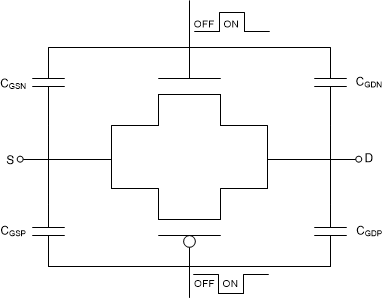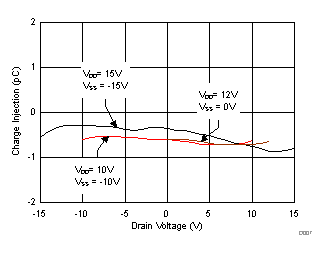SCDS397A November 2018 – October 2022 TMUX6136
PRODUCTION DATA
- 1 Features
- 2 Applications
- 3 Description
- 4 Revision History
- 5 Pin Configuration and Functions
-
6 Specifications
- 6.1 Absolute Maximum Ratings
- 6.2 ESD Ratings
- 6.3 Thermal Information
- 6.4 Recommended Operating Conditions
- 6.5 Electrical Characteristics (Dual Supplies: ±15 V)
- 6.6 Switching Characteristics (Dual Supplies: ±15 V)
- 6.7 Electrical Characteristics (Single Supply: 12 V)
- 6.8 Switching Characteristics (Single Supply: 12 V)
- Typical Characteristics
- 7 Detailed Description
- 8 Application and Implementation
- 9 Power Supply Recommendations
- 10Layout
- 11Device and Documentation Support
- 12Mechanical, Packaging, and Orderable Information
Package Options
Mechanical Data (Package|Pins)
- PW|16
Thermal pad, mechanical data (Package|Pins)
Orderable Information
7.3.2 Ultralow Charge Injection
The TMUX6136 is implemented with simple transmission gate topology, as shown in Figure 7-14. Any mismatch in the stray capacitance associated with the NMOS and PMOS causes an output level change whenever the switch is opened or closed.
 Figure 7-14 Transmission Gate Topology
Figure 7-14 Transmission Gate TopologyThe TMUX6136 utilizes special charge-injection cancellation circuitry that reduces the drain (D)-to-source (Sx) charge injection to as low as –0.4 pC at VS = 0 V, as shown in Figure 7-15.
 Figure 7-15 Charge Injection vs Drain Voltage
Figure 7-15 Charge Injection vs Drain Voltage